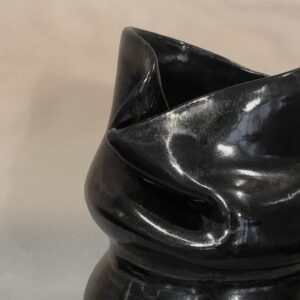CERAMICS, ERROR & IMPERFECTION
The topics of loss of control and error, among others, are explored by Santiago R. Pérez in the essay ”Loss of Control: Error, Glitch, and Imperfection in Architecture”. The loss of control in the instance of the pottery process emerges as I move out of sync with the potters wheel, disrupting the symmetry and producing an error. This could be seen as a gestural mode of control as the result follows the artists movement. (Pérez, 2017)
”The elimination of error is founded upon the notion of a preexisting norm, acceptable range of values, or, in the physical space of craft, the relation to a geometric ideal [form] or design specification.” (Pérez, 2017)
In my pottery I have a tendency to fall into the trap this notion, only creating within the framework of what is the ”correct” way of doing pottery. But, by engaging in the error and loss of control as a tool for design in craft, the material can be explored beyond its idealized shape. The collapse has its own set of aesthetic possibilities, that steps away from the rigidity and symmetry of the throwing process. This can be use as a part of the ceramic process, simulating collapse partially to create unique pieces.

A quality that many clays and ceramic materials inhabits is the mark of the handmade. Wether it is an actual mark of the makers hand or a slight imperfection; the differences in shapes, size and small colour variations that bears witness to this feeling. Pérez describes imperfection as a deviation from ideal state and in reference to David Pye explains that the relation to the ”imperfect” is one of the major differences between machine made and handcrafted. (Pérez, 2017)
”Indigenous clay and mud architecture in various parts of the world seem to be born of the muscular and haptic senses more than the eye.” (Pallasmaa, 1996)
Perhaps it is in the imperfections that this muscular and haptic sense that Pallasmaa describes lies? In the traces of the people that built it. When building with bricks each stone is a place to leave a mark, and when the clay is fired the mark will be for-ever imprinted in the stone. Although he exact traces and where they come from might be hard to see in the finished wall, they are intended to be experienced as a whole. It is in the slight variations that the material quality lie.